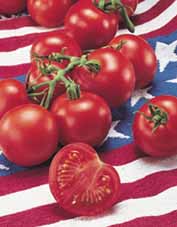
The United States Congress passed the Tariff Act of 1883, a rather innocuous piece of legislation requiring a 10% tax on imported vegetables, in response to growing international trade. Just a few short years later, a tomato importer evaluated the law closely, and decided to challenge it on the botanical grounds that a tomato was in fact technically a fruit, not a vegetable, and should therefore be exempt from said tax. John Nix's case posed merit enough to land the case before the Supreme Court in 1893. In Nix vs Hedden, 149 U.S. 304 (1893), Justice Gray wrote, "Botanically speaking, tomatoes are fruits of a vine, just as are cucumbers, squashes, beans, and peas. But in the common language of the people...all these are vegetables, which are grown in kitchen gardens, and which, whether eaten cooked or raw, are, like potatoes, carrots, parsnips, turnips, beets, cauliflower, cabbage, celery and lettuce, usually served at dinner in, with or after the soup, fish or meats which constitute the principal part of the repast, and not, like fruits generally, as dessert [1]." The court rejected the botanical truth that the tomato is in fact a monstrously sized berry, and deferred to the culinary vernacular of vegetable to describe it. Thus is tax yet paid on imported tomatoes.
The giant berry traded abroad has a colorful history, and the story above is typical of a fruit that originated in one hemisphere, became popular in another, and returned back close to home for intense breeding that produced the tomato now familiar to most people today. Lycopersicon esculentum now enjoys worldwide distribution and is integral to the culinary disposition of multiple cultures.
Where did the tomato come from? For more than a century, tomatoes have been grown in gardens from Kazakstan to California, and in many locales cultivation of the red fruit goes back centuries. Pinpointing where it all began is not always easy. Vavilov was a renowned Russian scientist who conceived the idea that if one wants to locate the very center of origin for any crop species, look for the area which still has the highest diversity of that crop [2]. This is grounded on the idea that only a portion of the wild plant gene pool will be incorporated into a domesticated plant line, such that the cultivated crop will represent only a portion of the genetic variety found in the wild ancestors which presumably are still inhabiting the area, in more or less the same form, to this day. By that logic, one would look closely at the western coast of South America, in present day Peru (Fig 1), where eight species in the tomato genus still grow wild in the Andes Mountains (Table 1) [3]. The current range of wild tomato relatives extends from the northern tip of Chile on the south, to Ecuador on the north, and reaching inland from the Pacific 100-200 miles, also including the Galapogos Islands.
Tomatoes belong to the genus Lycopersicon, which is in the same family, Solanaceae, as potatoes. The resemblance betwixt leaves and flowers of potato and tomato plants seems to validate this taxonomic grouping. Two members of the genus Solanum (the genus which potato is classified in) have been successfully hybridized with members of the Lycopersicon genus [4]. These are S. lycopersicoides and S. pennellii. Wild tomato species have tiny fruits, and only the red ones are edible. Tomato plants do not tolerate frost, and grow as annuals in colder regions. In warmer regions, they are perennial, and flower regardless of day length.
All members of the genus have perfect flowers (hermaphroditic). Cultivated tomato is self fertile, whereas all other members of the genus are self-incompatible [5], with the exception of L. pimpinellifolium, which undergoes various degrees of self-fertilization. The major feature of domestication, aside from increased fruit size, is the gradual shortening of the flower style length from very long and prone to outcrossing, to very short and outcrossing-inhibitive(Fig 2). Full enclosure of the pistil by the anthers, a feature which virtually guarantees self-fertilization, did not occur until 1965 in California, although early North American and European cultivars were close to this state [6].
http://lamar.colostate.edu/~samcox/Tomato.html
'Remainder > Fruit' 카테고리의 다른 글
| I Say Tomayto, You Say Tomahto...4 (0) | 2008.06.28 |
|---|---|
| I Say Tomayto, You Say Tomahto...3 (0) | 2008.06.28 |
| I Say Tomayto, You Say Tomahto...2 (0) | 2008.06.28 |